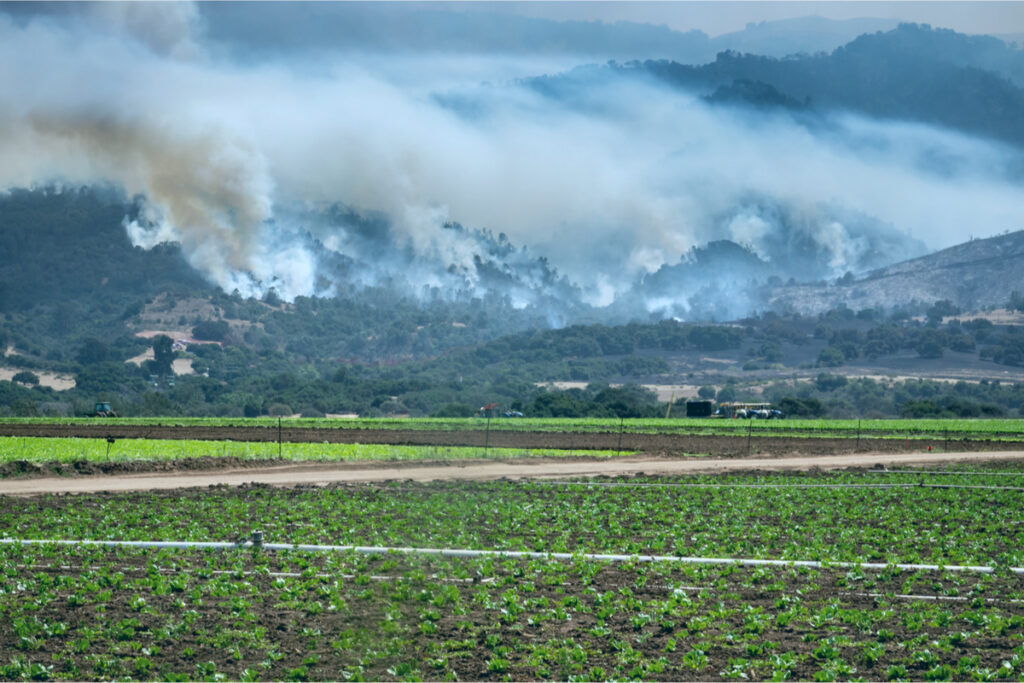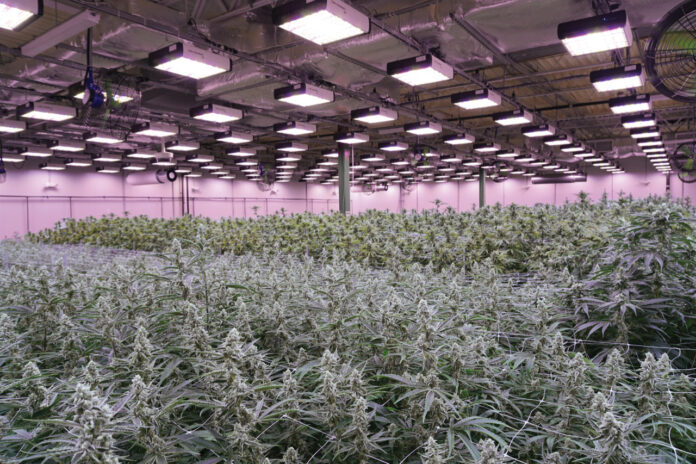To the outside world, the legal cannabis industry appears to be one big cash machine. While it’s true lots of money can be made, the price of doing business can be steep, particularly for those at the pyramid’s foundation—growers. Beyond direct cultivation costs like utilities, nutrients, and labor, farmers must move their crops from fields to distributors, processors, and retailers. And let’s not forget state and local jurisdictions’ off-the-top cuts in the form of taxes and fees to get a cultivation license.
The so-called “green rush” has been tough on smaller, boutique growers as the focus has shifted to large-scale cultivation. In fact, facilities larger than 250,000 square feet, capable of yielding more than 50,000 pounds of flower, are not uncommon anymore. For example, Arizona is home to the largest greenhouse complex in the United States: 300 acres, or 13 million square feet.
Although expensive, cultivation—or at least cultivation licenses—can be extremely profitable. For instance, Florida, with a population of more than 21 million, has licensed only thirteen companies, all for seed-to-sale operations. In 2017, one of those licenses sold for $40 million before the company earned its first cent. Another license sold for $53 million in 2018. New York, with a population of 20 million, has issued ten vertically integrated licenses, one of which fetched $26 million pre-revenue.
Indoors vs. outdoors cultivation costs
Indoor grows typically are more cost-intensive, thanks to rents as high as $75 per square foot in some places. (The nationwide average is about $50 per square foot for greenhouse and combination grows.) Indoor operations also pack on the expense because every aspect of the environment must be controlled. That means loading up on equipment like grow lights, systems for temperature and humidity control, and automated water and nutrient technology. A state-of-the-art lighting system can set even small growers back $120,000, security systems can run $50,000 or more, and other necessary equipment lands about $150,000 on the balance sheet. A lean operation could see gross profit of 55 percent to 57 percent, depending on state and size.
Outdoor grows, on the other hand, use the light of the sun and let Mother Nature manage the environmental controls. That can be a double-edged sword, though, because Mother Nature can be temperamental. Land averages $10 to $17 per square foot, although in some locations the cost can be significantly higher. Labor, too, may cost more because automating tasks can be more difficult.
While sun-grown operations can produce multiple harvests per year in temperate states like California, cultivators in states with short growing seasons—Colorado, Ohio, Illinois, and New York, for example—must grow at least some crops indoors if they intend to operate year-round.
Cooperatives reduce costs
Some small and mid-size cultivators have found banding together in collectives or cooperatives can help them reduce expenses enough to compete with bigger operations. The opportunity is not available in all states, but California’s Medicinal and Adult-Use Cannabis Regulation and Safety Act allows groups of three or more cultivator licensees to farm together as long as each license covers no more than 10,000 square feet of outdoor canopy and the collective incorporates no more than four acres.
Co-ops allow growers to spread fixed cultivation costs like rent, equipment leases, bulk purchasing, insurance, and labor across all partners. Members can enter into collective marketing agreements, which allow them to offer customers a steadier and larger supply of uniform products. The economy of scale creates a more competitive market position than growers could attain on their own, while still allowing the time and attention required for producing high-quality appellations and artisanal strains. The cooperative model also eases the pain of licensing and regulatory compliance through group access to consultants, accountants, and attorneys familiar with the group’s operating model.
So, how much does it cost to make money growing weed? The answer varies by state. To find out, we spoke with cultivators, consultants, and suppliers about fees, gripes and challenges, and ways they manage expenses.
Nevada
When Nevada went recreational, the state had one major concern: whether supply would be able to keep up with demand. Partially, that was due to the state’s high taxes and fees: Cultivators pay $5,000 for the application, plus $30,000 for the initial recreational grow license and a $10,000 annual renewal fee. Medical grows pay the same $5,000 application fee but only $3,000 for the initial license and $1,000 per annual renewal. Wholesale excise taxes are assessed by the Nevada Department of Taxation at 15 percent of what the department determines to be fair market value. Cities and counties may add fees and taxes of their own. Add in labor, utilities, nutrients, and other expenses, and cultivators easily can spend hundreds of thousands of dollars before selling their first bud.
Despite the expense, Solaris Farms is expanding its indoor grow from 34,000 square feet to 350,000 square feet. According to Chief Executive Officer Michael Sassano, in Nevada the industry is all about scale, and the “the bigger, the better.”
“Our costs are pretty typical of the state,” he said. “Water and power averages $10,000 for summer months, and $8,000 for winter months. Labor, the biggest cost, is $60,000 a month.” Solaris also allocates $10,000 monthly for technology and automation, $4,000 monthly for fiberoptic cable and computer software updates, and $3,000 a month for lab testing.
“Our costs are much different from outdoor [grows] or normal greenhouses,” Sassano said. “Not only must your product look and be amazing, but your facility must also. Upkeep and efforts to remain on the cutting edge cost money, but if you do it smartly you will be successful. We currently are at $333 a pound in costs and trending to $150 a pound without sacrificing anything, because we are improving yield and quality.”
Oregon
In Oregon, where the state increased license awards after early product shortages, flower prices are declining, which is driving boutique cultivators out of business. Larger growers must operate lean. The good news—and the bad news—is Oregon has among the lowest application fees in the country: $250. The state taxes only retail sales of recreational products.
Jazen, a cultivator at Wisely Organics, said an estimated 20 percent of the 20,000-square-foot indoor grow’s revenue goes to federal and state income taxes. The grow budgets another 5 percent for cultivation licensing and regulatory fees; 10 percent for water, power, and other utilities; and 15 percent for rent and supplies. Like most other cultivators nationwide, Wisely’s biggest cost is labor, at 42 percent. Although the trend in the state is to replace workers with tech, Wisely puts a premium on employees. “We are intentionally low-tech,” Jazen said. “Our highest tech is a skid steer tractor. We tried a trim machine to replace workers and found very quickly the workers produce better product. We now use the machine on only 2 percent to 5 percent of harvest batches.”
Like other farms its size, Wisely balances cultivation costs with environmental friendliness, and some techniques save money. For instance, Wisely focuses on building living, organic soil with local natural inputs and organic wastes. “We grow with regenerative, highly efficient, sustainable practices that produce quality craft cannabis at significantly lower cost,” Jazen said. “We strive to avoid expensive technologies, practices, nutrients, vendors, and gimmicks marketed to cannabis growers.”
The biggest gripes among Oregon cultivators are out-of-state ownership and too many licenses in a relatively small market. When supply proved insufficient to meet demand in the beginning, the state overcompensated. The resulting weed glut has left farmers in a financial bind. Jazen believes the state should not have issued licenses to out-of-state owners until interstate trade opened. “We need interstate commerce immediately,” he said. “Based on the costs of production, price, and low-quality cannabis in other states, our cannabis will be in high demand in the interstate market.”
Ohio
In Ohio, cultivator licenses are broken down in two levels. At level I, which allows a canopy up to 3,000 square feet, growers pay an application fee of $2,000, initial license fee of $18,000, and an annual renewal fee of $20,000. Level II growers, who may cultivate up to 25,000 square feet of crops, pay an application fee of $2,000, an initial fee of $80,000, and an annual renewal fee of $200,000.
Andrew Rayburn, chief executive officer at Buckeye Relief, which operates a 60,000-square-foot grow, said he budgets 2 percent of projected annual revenue for payroll taxes, 3 percent for licensing fees, 3 percent for water and power, 24 percent for labor, 17 percent for rent and supplies, and 1 percent for technology. “The bulk of our costs are labor, rent, and security,” he said, adding that his biggest challenge in managing costs is the small number of retail outlets attendant upon a young market. He expects product demand to increase, though. “It’s getting better quarter by quarter,” he said.
He also said investing in ever-improving technology is essential for managing other costs. The grow’s automated environmental control system, for example, trims costs associated with wasted water and nutrients; LED lights reduce heating and cooling costs.
Though fees are high compared to current production, Rayburn said Ohio growers see a future filled with promise. “Our regulators have been great partners,” he said. “They are open to suggestions for improvements to make the program work for patients, retailers, and suppliers.”
California
Annual application and cultivation licensing fees—which range from $135 to $8,655 and $2,420 to $77,905, respectively, plus a weigh-master license of $155—are relatively low in the country’s largest and most mature market, but taxes can be onerous. The state assesses $9.25 for each dry-weight ounce of flower, $2.75 per dry-weight ounce of trim, and $1.29 per ounce of fresh plant, or $5,000, whichever is greater. In addition, cultivators pay an excise tax of 15 percent of average market value, even if their crops sell for less or not at all. Counties and municipalities may add additional taxes and fees. Some jurisdictions also apply a land use tax even if a field is fallow.
As if those weren’t enough, most supplies and equipment purchased for business use are subject to state sales tax. Farm equipment, buildings, solar power facilities, and diesel fuel may qualify for a partial tax, but liquified petroleum gas (LPG) does not.
Almost everyone along the supply chain believes California’s tax structure is the single biggest contributor to the state’s notoriously problematic black market.
Aside from taxes and fees, the biggest costs are packaging, distribution, marketing, and labor. Like many other legacy Northern California farms, Swami Select, a mid-size outdoor grow, is off the grid. The operation annually pays $750 irrigation and $25,000 Fish and Wildlife permits for its rain catchment pond, but water and electricity consume only $2,500 annually. “We’re largely on solar power,” said owner Swami Chaitanya. “But we do spend about $5,000 annually for gas to run the backup generator for extra power to run dehumidifiers and fans during harvest and drying and for compost tea brews every two weeks in summer.”
Technology at the farm includes a dissolved oxygen meter to test aerobic compost teas, walkie-talkies to communicate on the sprawling property, and a drone outfitted with a high-powered scope to shoot photos of the grow from above. The equipment’s purchase price set the farm back a bit, but maintenance fees are moderate. “We also are required to have water meters now for information,” Swami said. “But none of this has affected our workers. We still have trimmers. They just can’t be working here on our property now as we do not have commercially permitted buildings for them.”
The cost of doing business increases every time regulators or legislators make changes to the rules, adding outlay for consultants; lawyers; accountants; electrical, carpentry, and plumbing contractors; compliance officers; geologists, foresters, and biologists; designers; and marketing professionals. Most state and county agencies periodically mandate upgrades to address security concerns and zoning restrictions.
Joshua Keats, co-founder and president at Henry’s Original, spends much of his time trying to manage taxes and labor shortages. “It can be difficult to find enough staff for peak periods around harvesting and planting,” he said. “Additionally, as we scale, we frequently have to pay overtime and hire expensive contract labor.”
Henry’s operates 92,000 square feet of greenhouse and hoop house space. According to Keats, the farm pays combined state and local cultivation taxes of $148 per pound. In addition to state excise tax, the company pays a 2.5-percent gross receipts tax to Mendocino County. Although the amount fluctuates with the product’s market value, the total is roughly $25 a pound.
Because the grow uses rain catchment ponds, water is among its lowest expenses. “As a sun cultivator, we don’t use huge amounts of electric power [either],” Keats said. “Our nursery uses some lighting, dehumidification, and fans for air circulation and cooling, and our flower farms use irrigation pumps and air pumps for mixing fertilizer teas. Spread out, I would estimate electric power to cost us about $10 per pound.”
Thanks to negotiation, Henry’s lease costs only $30 per pound, significantly lower than average. Labor is the operation’s largest expense: $150 to $200 per pound. With a team of more than 100 people, the farm is one of the largest employers in Mendocino County. “For us, technology will never replace a good worker,” Keats said. “But it does allow us to operate more efficiently during peak growing seasons or when there’s a labor shortage. Planting and harvesting are still very involved processes requiring many hands. As we expand from two to twenty acres, we plan to implement standard farming machinery that will allow us to prepare our soil and plant more efficiently and with smaller crews.” Because finding enough staff for harvesting and planting season can be difficult, he expects to pay overtime wages and hire expensive contract labor as the farm grows.
Keats said fertilizer, inoculants, and pest management expenses are minimal. “We estimate approximately $10 per pound for these inputs,” he said. Technology for soil monitoring, irrigation, and fertilizing allow lower labor costs. “We also pest-scout with high-powered digital microscopes, allowing us to deploy pest management resources only when signs of increased populations surface,” he said.
Colorado
Like California, Colorado also levies a 15-percent excise tax based on average market rate, with a 2.9-percent additional fee on some transfers. What really bites Colorado cultivators, though, is utility expenses. Indoor operations—the most common type in the state—account for 10 percent of Denver’s total electricity consumption. Every watt of lighting produces heat, so cooling requires additional resources, often in the form of water-chilled HVAC systems.
“The two big energy sucks are the climate systems and lighting,” said Brandy Keen, vice president of sales for environmental equipment design-and-manufacturing company Surna. “You’ve basically got thousands and thousands of watts of heating in a space that needs to be at 78 degrees for the plant.” Cultivators are attempting to mitigate some expenses by migrating from warehouses to greenhouses, which cost about half as much to operate. Even in greenhouse environments, electricity costs can top $350 per pound.
Real estate presents its own set of challenges. “The big difficulty is finding a location where the city will allow you to construct a greenhouse,” said Dave Gardner, senior horticulturist with consulting firm Colorado Cannabis Systems. “Even if you find a piece of property, you really need to purchase that property. To develop it and build the greenhouse, that’s a huge [up-front] cost.”
Colorado’s over-supply has lowered prices, exacerbating profitability concerns among the state’s 1,300-plus grows. Joshua Haupt, chief cultivation officer at Medicine Man Technologies and author of the book Three a Light, said falling prices mean growers must find ways to reduce average cultivation costs from the current $800 to $1,000 per pound to around $400 a pound to remain competitive. He suggested technology and artificial intelligence are keys. “Cultivators need technology that keeps them updated in real time on their cost information at every step of the process to ensure they are identifying ways to reduce costs,” he said. “Every step of the production process represents an opportunity to reduce costs, but only if you have the information necessary to identify those opportunities. By tracking costs and staying aware of industry performance standards, cultivators will be better equipped to compete in this rapidly changing market.”
Colorado cultivators have become experts at cutting costs using green alternatives including renewable energy, LED lights—which can be 60-percent more efficient than other bulbs—and water efficiency via reverse osmosis systems that can recycle 75 percent to 97 percent of water used in irrigation or other parts of cultivation.
Regardless a grow’s type, size, or location, the path to profitability lies in creativity, flexibility, efficiency, and funding. Luck plays a role, as does governmental greed. To mitigate the latter, maintain good communication and friendly relationships with state and local politicians, regulators, community members, and growers’ associations.

Cultivation Licensing, Application Fees, and Taxes by State
The information below pertains only to states that do not require vertical integration. Current information for states with new programs or programs in transition may not have been available at press time (for the October, 2019 issue of mg Magazine).
Alaska
- Application: $1,000
- License: $1,000 to $5,000, depending on size
- Annual renewal: $1,400
- Taxes: $50 per bud ounce or $15 per trim ounce
Arizona
- Application: $5,000
- Initial registration: $5,000
- Annual renewal: $1,000
Arkansas
- License: $100,000
California
- Annual license application: $135 to $8,655, depending on size and type
- Annual license: $2,420 to $77,905
- Taxes: $9.25 per dry-weight ounce of flower, $2.75 per dry-weight ounce of trim, $1.29 per ounce of fresh plant (weighed within two hours of harvesting), plus 15 percent of average market price
Colorado
- Application: $4,000
- Annual license: $1,100 to $5,300, depending on size
- Taxes: 15 percent of contract price or average market rate calculated by the state; 2.9-percent transfer fee on some transactions
Connecticut
- Application: $25,000
- License registration: $75,000
- Annual renewal: $75,000
- Taxes: $3.50 per gram
Delaware
- Application: $5,000
- Certification: $40,000 (paid every two years)
District of Columbia
- Application: $5,000
- Annual renewal: $3,000
- Annual registration: $5,000
Illinois
- Application: $25,000 to $100,000, depending on type
- License: $100,000 every two years
- Business development fee: $250,000 to $750,000
- Taxes: 7 percent wholesale excise
Maine
- Application: $300 per patient
- Annual license: $300 per patient
- Taxes: $335 per pound on flower and mature plants, $95 per pound on trim, $150 per immature plant or seedling, 30 cents per seed
Maryland
- Application: $6,000
- Annual license: $125,000
Massachusetts
- Application: $100 to $600, depending on size and type
- Annual license: $625 to $25,000
Michigan
- Application: up to $8,000
- License: $10,000 to $67,000, depending on size
Minnesota
- Application: $20,000
- Annual license: $75,000 to $100,000
Missouri
- Application: $10,000
- Annual renewal: $25,000
Montana
- Annual license: $1,000 to $5,000, depending on number of patients
Nevada
- Application: $5,000
- Initial license: $30,000
- Annual renewal: $10,000
- Taxes: 15 percent of fair market value as determined by Nevada Department of Taxation
New Hampshire
- Application: $3,000
- Annual license: $40,000 to $80,000, depending on location
New Mexico
- Application: $10,000
- Annual license: $30,000 to $90,000, depending on number of plants
North Dakota
- Application: $5,000
- License: $110,000
Ohio
- Application: $2,000 to $20,000, depending on size
- License: $18,000 to $180,000, depending on size
- Annual renewal: $20,000 to $200,000, depending on size
Oklahoma
- Application: $2,500
Oregon
- Application: $250
- Annual license: $100 to $5,750, depending on size
Pennsylvania
- Application: $210,000
- Annual license: $10,000
- Taxes: 5 percent wholesale excise
Rhode Island
- Application: $5,000
- Annual license: $5,000 to $80,000, depending on size
Utah
- Application: $10,000
- License: $100,000
- Annual renewal: $100,000
Washington
- Application: $250
- Annual license: $1381
West Virginia
- Application: $5,000
- Annual license: $50,000
- Taxes: 10 percent wholesale excise











